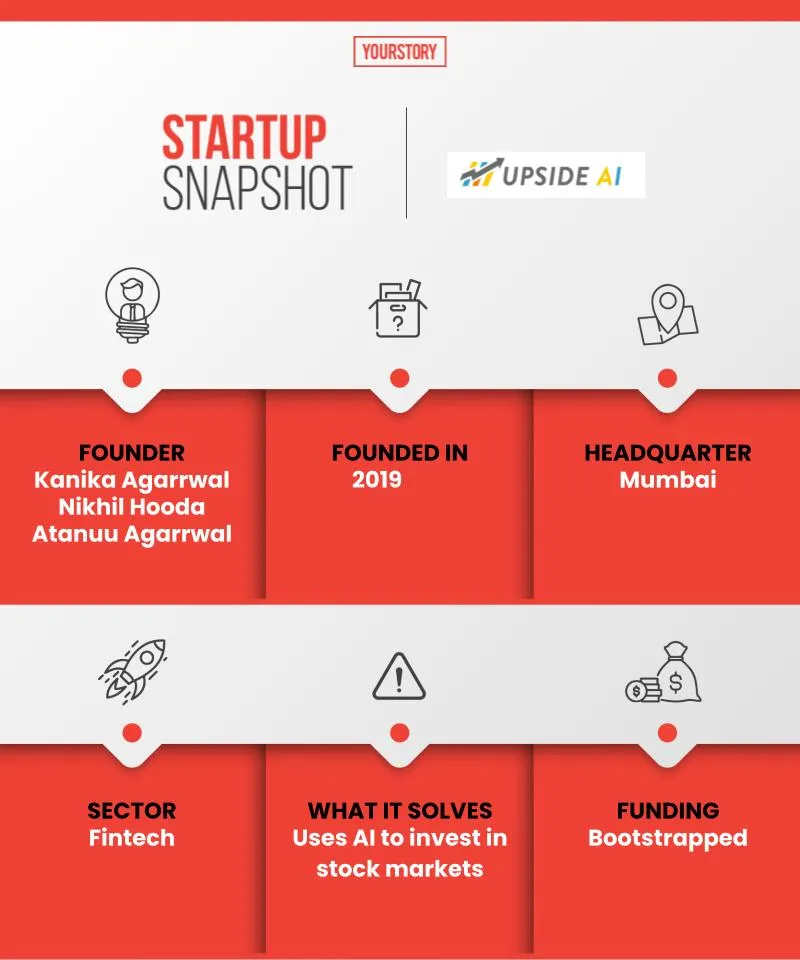This bootstrapped startup aims to make stock market investments AI-driven
Upside AI is a Mumbai-based investment firm that uses machine learning and fundamental analysis to invest in the Indian stock market.
Kanika Agarrwal, Atanuu Agarrwal, and his friend Nikhil Hooda believe artificial intelligence (AI) is the new Warren Buffett. This got them to start Upside AI in December 2017.
Kanika says, “We started Upside AI with the belief that technology should be at the core when it comes to making fundamental investment decisions. This is because we believe technology will make better decisions than humans over the long term since machines are unbiased and unemotional decision-makers.”
The Mumbai-based startup is an investment company that uses machine learning and fundamental analysis to invest in the Indian stock market.
Over the past year, the startup claims to have generated 52 percent returns for its investors.

Kanika Agarrwal, Co-founder, Upside AI
How does it work?
Investors can feed their profit and loss (P&L) statement, balance sheet, and cash flow data into the ML algorithm. The algorithms teach themselves to understand companies that are not only fundamentally good businesses but are also in-demand stocks. At the end of its analysis, it gives a breakdown of what sectors as well as companies people should be investing in.
“We then manually check each company suggested for corporate governance and management integrity because the whole idea is to invest in fundamentally good companies to buy and hold. We rebalance the portfolio every quarter as companies release financial results. We started building the algorithm in 2017, spent a year beta testing, and after two years in development, in July 2019, Upside AI started offering its investment products to external clients,” says Kanika.
The startup has two sides to the business - one is portfolio management services, which cater to HNIs, institutions, and family offices in India and globally. Here, it largely looks after Rs 50 lakh plus ticket sizes. The clients give money to Upside AI, which buys shares, handles them, and reports to the clients, but the team is in control of the investments.
“The other part of the business that we have recently launched and the one that we would like to announce slowly is the retail advisory vertical. Through the retail advisory business, it is our ambition to make sophisticated technology more accessible to India (which so far has solely been available to high net worth investors globally). Through a partnership with smallcase, we have been able to introduce best-in-class investment technology to consumers who can invest as little as Rs 30,000 to Rs 40,000 or even do SIPs of lower amounts,” says Kanika.
The journey
The main idea of starting Upside AI has been to eliminate human errors and biases in the fundamental decision-making process. However, the team faced its own set of challenges.
The first problem was building the tech itself. The challenges of AI are true across industries, including investing – data quality, the quality of the model built, solving qualitative investing issues like corporate governance and wider acceptance of the technology.
It took the Upside AI team a year to build and a year to test in live markets before they believed that they had a robust, dynamic, and differentiated product to take to market.
“Building a network of investors and distributors virtually from scratch is non-trivial and remains the biggest problem we tackle today,” says Kanika.
Additionally, convincing people to trust technology with their money is an upward climb because it’s new. Kanika says, the top funds in the world use technology to invest money in the stock market. She adds that close to 60 to 70 percent of the money in the US market is invested using tech.
“We could see tech-based investing becoming the norm, not the exception, and it was time India also became a part of that change. While tech plays a small role in the ecosystem in India, for e.g., for high-frequency trading or technical trading, we knew that it could do so much more. So when we built this, we said is AI going to be the next Warren Buffett? And that was really what we set out to build to replace human investors,” says Kanika.

Market and future
Upside AI claims it has an AUM of Rs 40 crore and has grown 7x in the last calendar year. The startup says its investor and distributor base is now pan India.
“We have single-handedly raised this amount since the launch of our product in July 2019. Over the last year (as of February 28, 2021), Upside AI has delivered 52 percent net of fees to its investors, while the NIFTY 500 index delivered 33 percent. As a result, the company has emerged as a top decile fund manager, i.e. Upside AI is in the top 10 percent of managers out of 200+ PMS schemes tracked,” adds Kanika.
Currently bootstrapped, Upside AI charges a percentage of fee per year to manage clients' money. It also takes a certain percentage of profit share based on how well they do for the clients. Most of the clients are based in India and the US.
On the portfolio management services (PMS) side, the clients include large family offices, VC fund managers, brokers, and C-Suite managers of large MNCs in India and the US.
Upside AI now competes with the likes of online brokerage firm Zerodha and investment firms like Groww. However, the startup focuses on larger offices as the size of equity investments in India are still small.
Kanika also says, “We are not too worried about competition because our industry is not ‘a winner takes all’ one. In fact, all logic points to always diversifying across asset managers.”
Over the next five years, the team hopes to be a multi-billion dollar asset management platform with a suite of products across equities, debt, and ETFs.
Speaking of their future, Kanika says, “We plan to introduce a large-cap/ mid-cap product this year. We introduced Upside 250 early this year that focuses on only the top 250 stocks by market cap as its universe.
"The idea is the same as Upside Multi-cap, i.e. to use machine learning to look for fundamentally good companies in the large and mid-cap universe. The stocks held in the top 250 are long-term buys and the portfolio is rebalanced annually only. We are currently beta testing a US mid and small-cap product. We are also building an asset allocator using machine learning to decide the split between equity, debt, commodities, etc. based on macro factors like interest rates, inflation, liquidity, etc.”
Edited by Megha Reddy



![[Product Roadmap] The evolution of Zerodha, one of India's largest retail online brokerages](https://images.yourstory.com/cs/2/a9efa9c02dd911e9adc52d913c55075e/img-800x400-1587448250328.png?fm=png&auto=format&h=100&w=100&crop=entropy&fit=crop)





